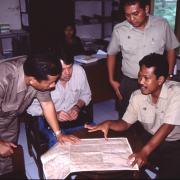Landscape Governance
Policy reforms and institutional change that support collaborative management efforts, such as community-based forest management in the Philippines, forest village development in Thailand and joint forest management in India, are attempts by respective governments to improve governance and balance the social, economic and environmental demands placed on forests.
Adopting good governance principles allows for transparency in decision-making and ensures stakeholder participation in the planning process in order to be equitable and inclusive. In our experience, failure to adopt these principles often results in management objectives that are either unattainable or seriously compromised. Additionally, a clear legal and policy framework is essential to avoid conflicting land use policies.
Our experience has found that natural resource management objectives are most effective and attainable when stakeholders are fully involved in the decision-making process. We use the strengths of the Model Forest approach to demonstrate principles of good governance and create practical solutions to improve decision-making, address the underlying issues related to illegal or unsustainable activities, and build capacity for forest conservation. We operate at the forest-farm interface to demonstrate that food security, livelihoods, cultural values and conservation priorities are not mutually exclusive when a good governance system is in place.
Find out more on what is happening in the Model Forests of Asia
